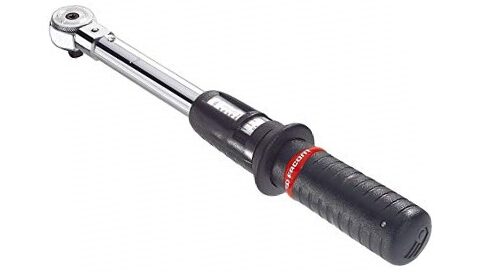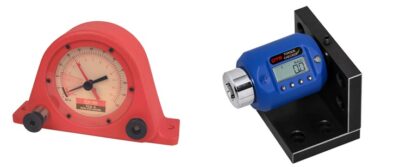Torque wrench
A torque wrench is a tool that measures the tightening torque when tightening a fastener. It is used to tighten nuts and screws to a predetermined torque. Tightening is done via a lever that finally has a socket connection similar to a socket wrench. To ensure that the appropriate tightening force reaches the screw, support the head of the torque wrench with one hand. Avoid using extensions as they make it difficult to support the head and transmit torque. Where necessary, use deep nipples instead of extensions. Manufacturers do not specify the tightening force for each nut and screw. For some tightening torque is defined, such as cylinder head bolts.
The torque wrench contains an adjuster and a tightening torque meter. The torque value can be defined in units of Nm (newton-meter), lb-ft (foot-pounds), or in-lb (inch-pounds).
There are several types of torque wrenches: Beam style, Clicker style, Dial, and Digital.
Beam-style torque wrench
This torque wrench has two levers. One is a drive lever, and the other is in the shape of an arrow that ends on numerous scales. This system uses a spring steel beam that bends under pressure. When applying the tightening force to the screw, the arrow rotates and shows the value on the scale. A beam-style torque wrench is the simplest but also the most inaccurate. One drawback of this design is that you have to be positioned directly above the scale so you can read it accurately. That can be a problem when working under the hood of a vehicle.
Clicker-style torque wrench
With this torque wrench, the required torque value is set first, followed by tightening. The torque wrench clicks when the required tightening torque is reached. This torque wrench is more accurate and the error goes up to 4%. Another advantage is that it is not necessary to monitor the torque value during use. When the set value is reached, it beeps. When the torque wrench clicks, stop turning it because it does not stop tightening. It is easy to miss the click and over-tighten, break, or strip the bolt.
Clicker-style torque wrench
Dial torque wrench
This type of torque wrench has a precision dial where the tightening force can be read accurately. The disadvantage, as with the beam-style, is that you constantly have to follow the dial during tightening. The advantage is that during tightening the dial remains at the highest measured value, so by moving the wrench we can continue tightening to the required force. Before tightening the next screw, it is necessary to return the meter pointer to zero.
Digital torque wrench
The digital torque wrench is the most precise and comfortable to work with. The measurement and display of the tightening torque are electronic and are shown on the meter display. Before using the torque wrench, the required value of the tightening force is set. During the tightening, the current torque value is displayed. When the required torque value is reached, an audible signal is heard. Sound advertising is useful in situations where the dial cannot be read.
Digital torque wrench
Torque wrench calibration
The torque wrench wears out over time and needs to be periodically checked and calibrated. This is done on a torque wrench calibration device.
Analog and digital torque wrench tester









